The Material Master in SAP is a fundamental component of the SAP system used to manage all materials or products that a company deals with. It serves as a central repository of information about materials, including raw materials, finished products, and semi-finished products. Here’s a breakdown of the key aspects of the Material Master : Creating a material in SAP, particularly for an example product like “Nexon EV,” involves several steps and the configuration of various material views.
In this SAP MM tutorial, we are going to create a Material in SAP called “Nexon EV”. When creating a material like “Nexon EV” (an electric vehicle example) requires defining its attributes across various material views. Each view represents a specific set of data relevant to particular business functions. We’ll cover the key steps to create this material and explore its essential views.
Creating a Material in SAP step by step
| Basic Data 1 – MM | MRP1 – PP |
| Basic Data 2 – MM | MRP 2 – PP |
| Sales Org Data 1- SD | MRP 3 , MRP 4 – PP |
| Sales Org Data 2 – SD | Plant Data Storage 1 – MM |
| Sales General Plant Data – SD | Plant Data Storage 2 – MM |
| Foreign trade export – SD | Accounting 1 – FI |
| Sales Text – SD | Accounting 2 – FI |
| Purchasing – MM | Costing 1 – CO |
| Foreign Trade Import – MM | Costing 2 – CO |
| Purchase Order Text – MM |
Tables in Material master
| MARA | General Data | Basic data1, basic data 2, Plant data storage 1, plant data storage 2 |
| MVKE | Sales data | Sales org data1, Sales Org data 2, Foreign trade export |
| MARC | Plant Data | Sales General Plant data, purchasing , MRP1, MRP2, MRP3, MRP4 |
| MBEW | Accounting | Accounting 1, Accounting 2 |
1. Basic View (Basic Data 1)
The Basic View contains fundamental information about the material, such as:
- Material Type: Categorizes the material (e.g., finished product, raw material).
- Material Group: Classifies materials based on shared characteristics.
- Material Description: Provides a clear and concise name or description.
- Base Unit of Measure: Specifies the primary unit for managing the material.
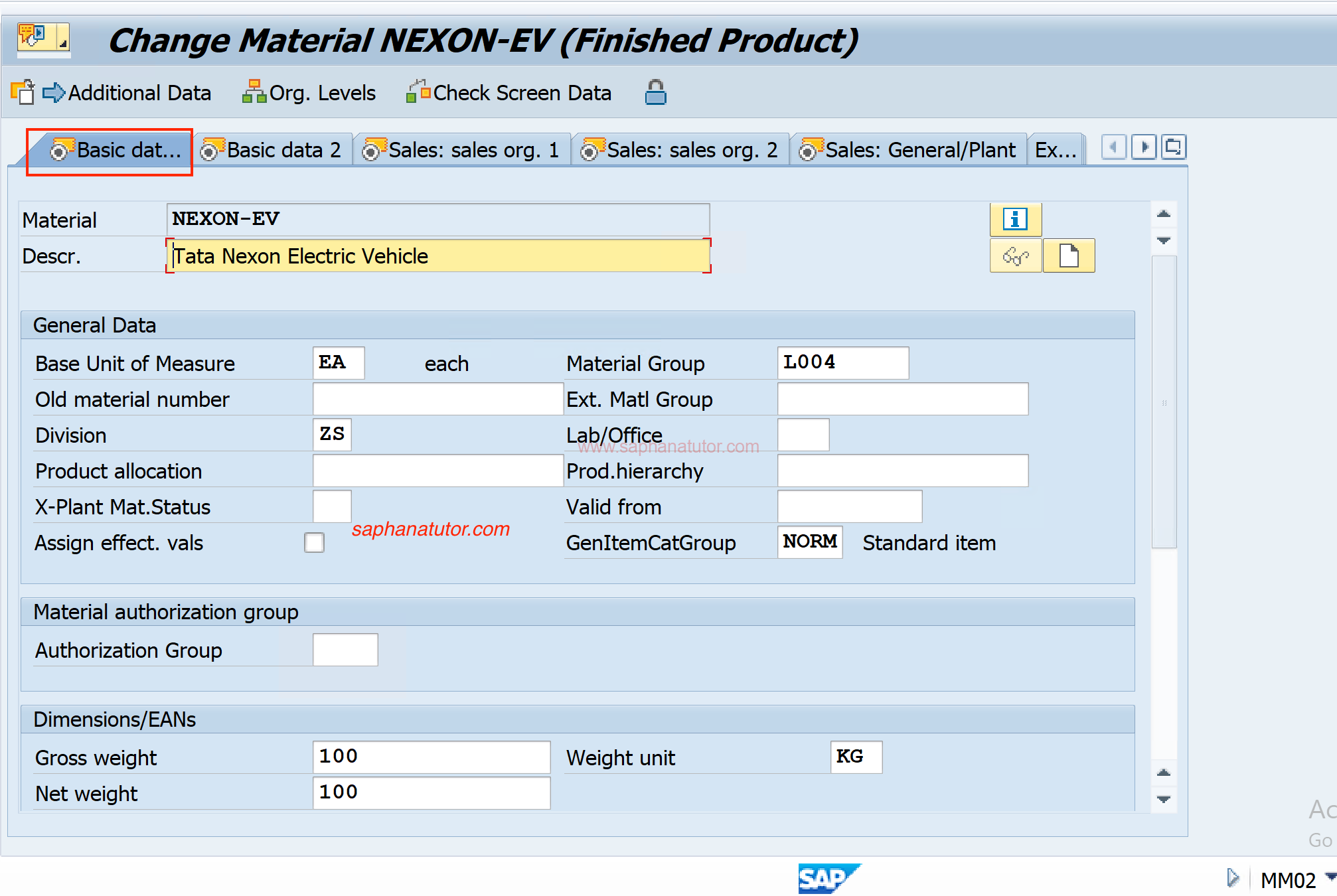
- Base Unit of Measure: This is the primary unit we use for making and storing products, like pieces, liters, bottles, etc.
- Material Group: This categorizes materials with similar features, mainly for reporting and pricing.
- Old Material Number: Use this field for referencing an old material number that’s different from the current SAP number.
- Division: The division set in the material master influences the sales document line item.
- Product Allocation: This is about setting aside stock for specific customers, customer groups, or distribution channels.
- X-Plant Material Status: Use this to block materials across all plants. This is relevant if a product has different labels.
- General Item Category Group: Determines the item category in the inbound delivery process.
- Gross Weight vs. Net Weight: Gross weight includes packaging, while net weight is just the product.
Sales: Sales Org 1
This view focuses on sales-related data and is crucial if the material is sold to customers. It includes:
- Sales Organization: Identifies the sales organization responsible for selling the material.
- Distribution Channel: Specifies the channel through which the material is distributed.
- Division: Divides materials further within the organization, if needed.
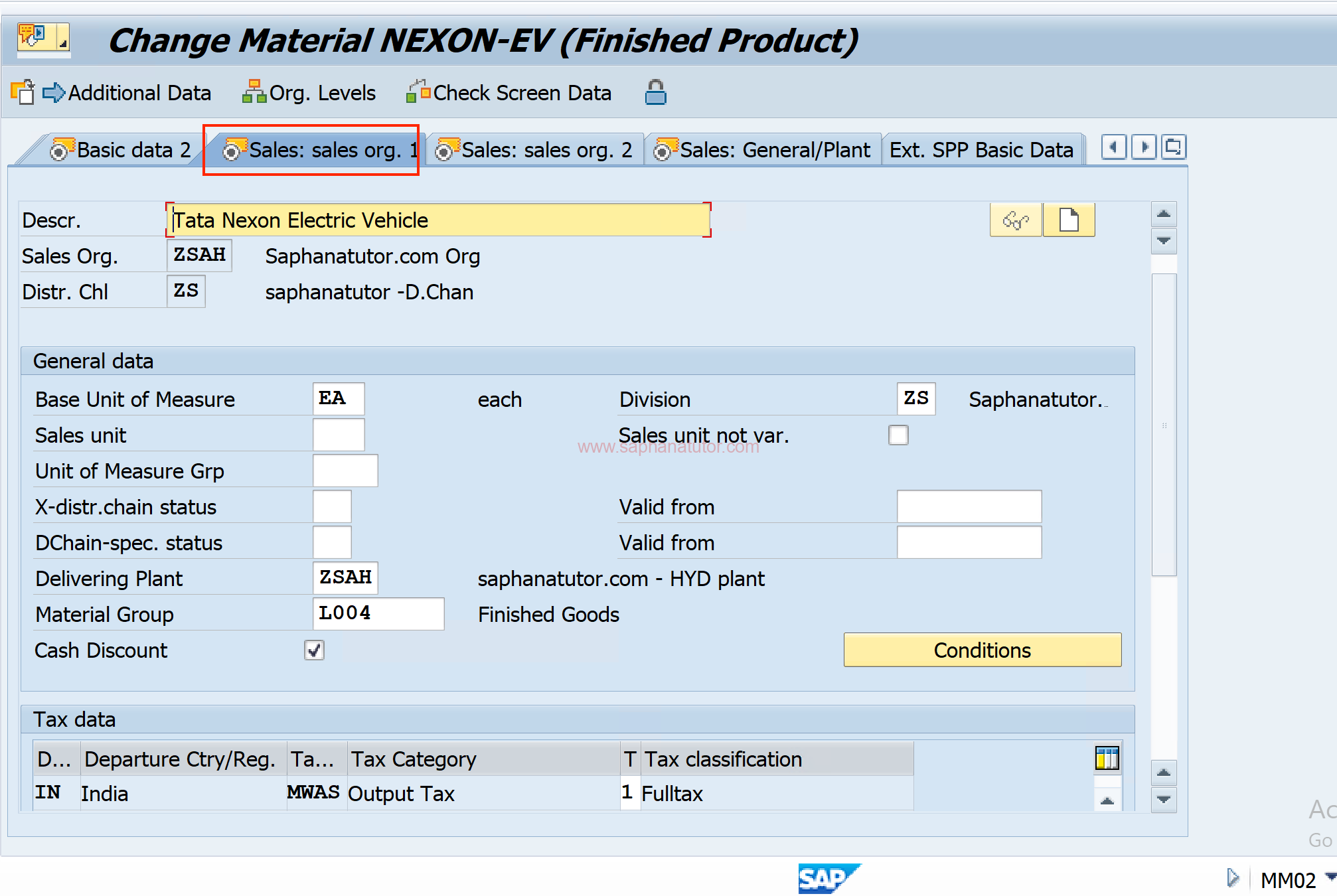
- Sales Unit: The unit in which goods are sold to customers. If it differs from the base unit, a conversion is needed.
- Sales Unit Consistency: This option prevents changes to the sales unit in sales documents.
- X-Distribution Chain Status: Blocks material sales across all distribution channels.
- D-Chain Specific Status: Blocks sales of materials in specific distribution channels.
- Delivery Plant: The chosen plant affects the sales document line item. Determined by CMIR, Customer Master, and Material Master.
- Cash Discount: Determines the cash discount condition in sales documents.
- Tax Classification: Decides if the material is taxable.
- Minimum Order and Delivery Quantities: The system checks these against order and delivery quantities, warning if they’re too low
Sales: Sales Org data 2 View
- Material Statistics Group: Controls updating of sales data.
- Material Pricing Group: Categorizes materials for pricing.
- Volume Rebate Groups: Used for group rebate strategies.
- Account Assignment Group: Affects revenue G/L account posting during invoicing.
- Item Category Groups: Determine item categories in sales documents (e.g., “NORM” for standard, “BANS” for third-party, “BANC” for IPO).
- Pricing Reference Material: Maintains pricing for one material and applies it to others.
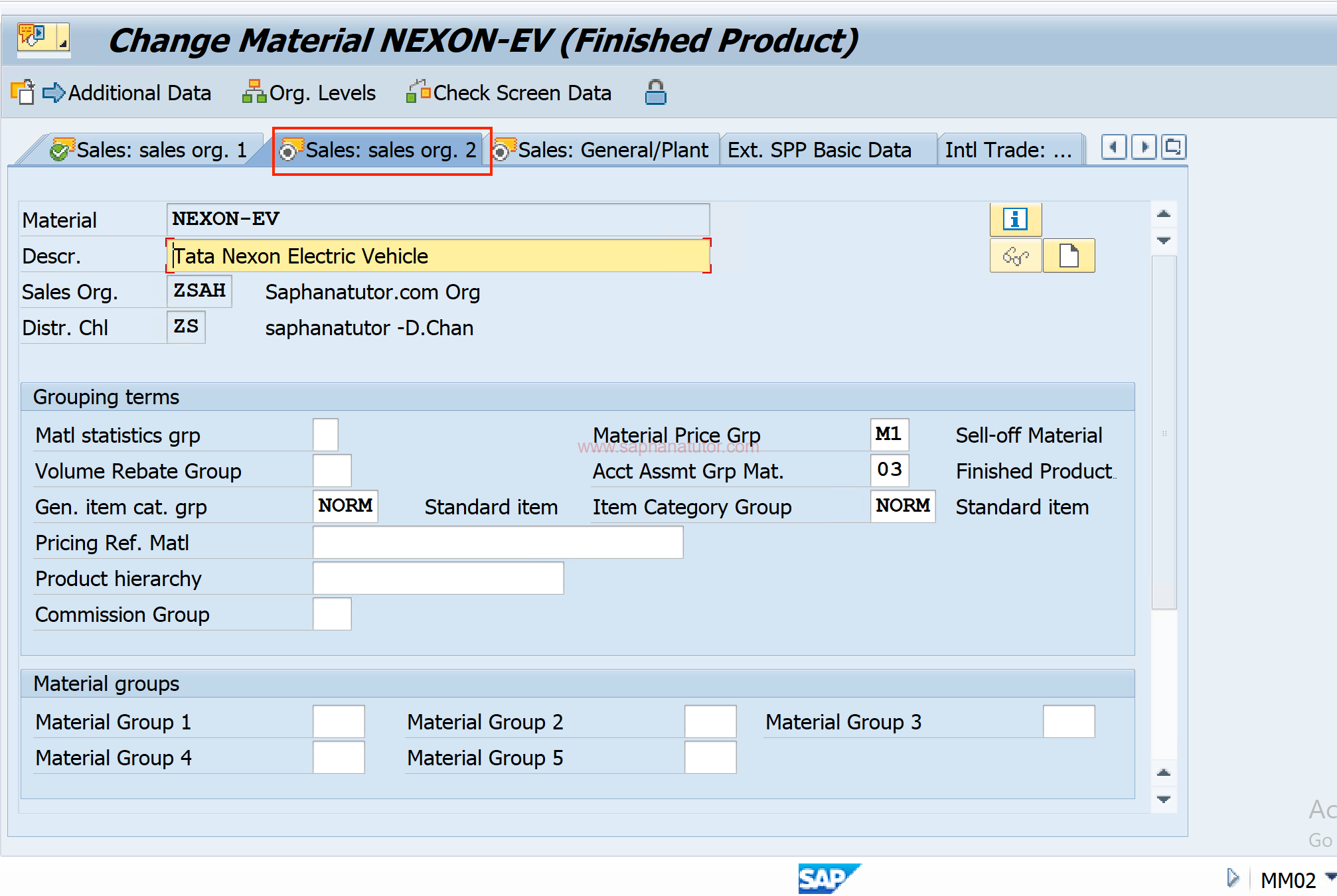
Sales:General/Plant view
- Availability Check: Essential for checking availability in sales documents and updating MRP.
- Batch Management: Tracks expiry, defects, and responsibility. Important if material is batch-relevant.
- Transportation and Loading Groups: Influence route and shipping point in sales documents.
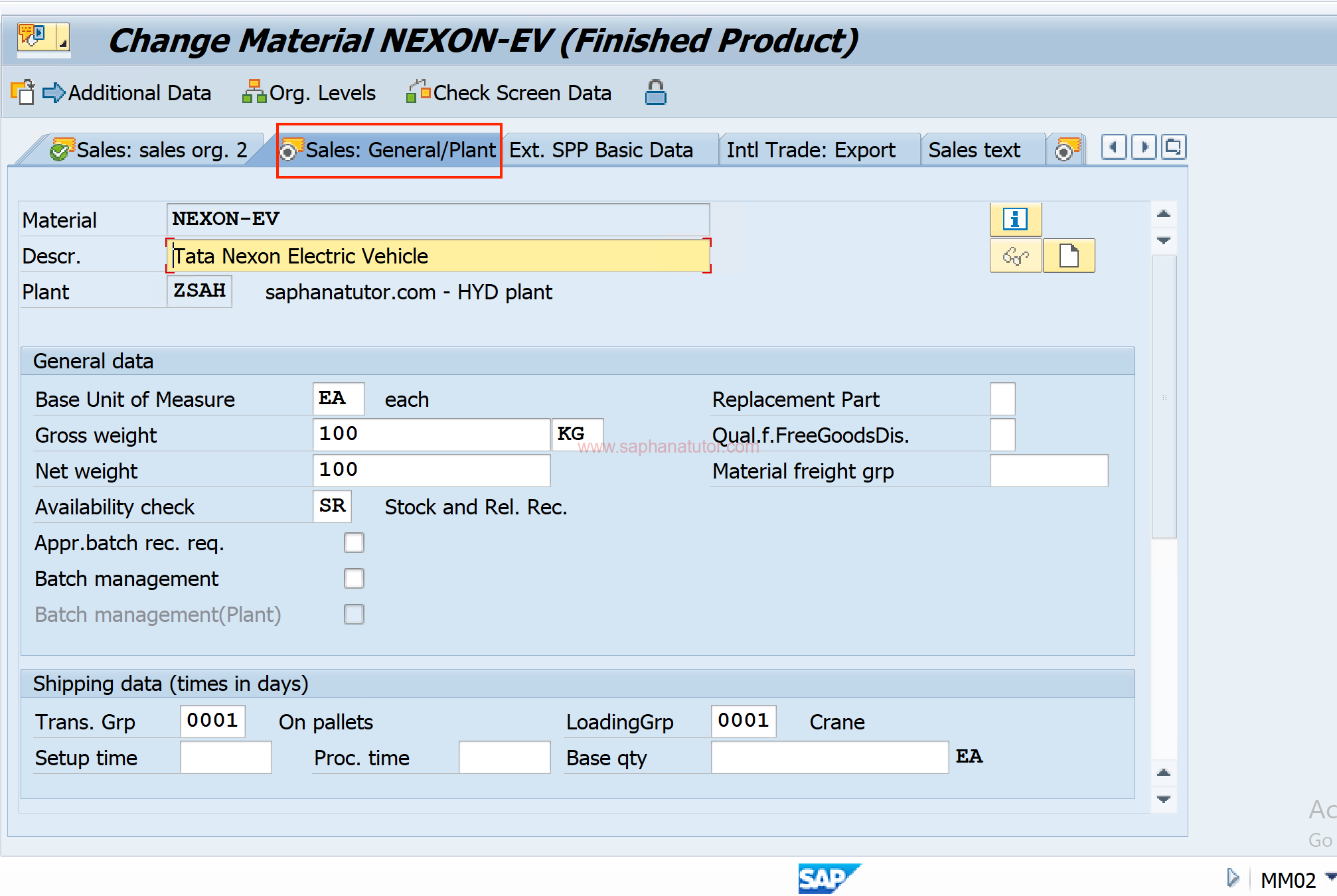
Purchasing View
The Purchasing View is essential for procurement processes and includes information such as:
- Purchasing Group: Assigns a group responsible for procuring the material.
- Vendor: Associates the material with a specific supplier.
- Material Group: Further categorizes the material for procurement purposes.
- Minimum Order Quantity: Specifies the minimum quantity that can be ordered.
MRP1 View
- MRP Group and Type: Affect planning relevance and requirement types in sales documents.
- MRP Controller: Person responsible for running MRP.
- Procurement Type, In House Production, Planned Delivery Time, Safety Stock: These influence manufacturing and stocking strategies.
- Strategy Group: Determines whether to make to stock or to order.
- Total Replenishment Lead Time: Time taken from manufacturing to storage, influencing delivery scheduling.
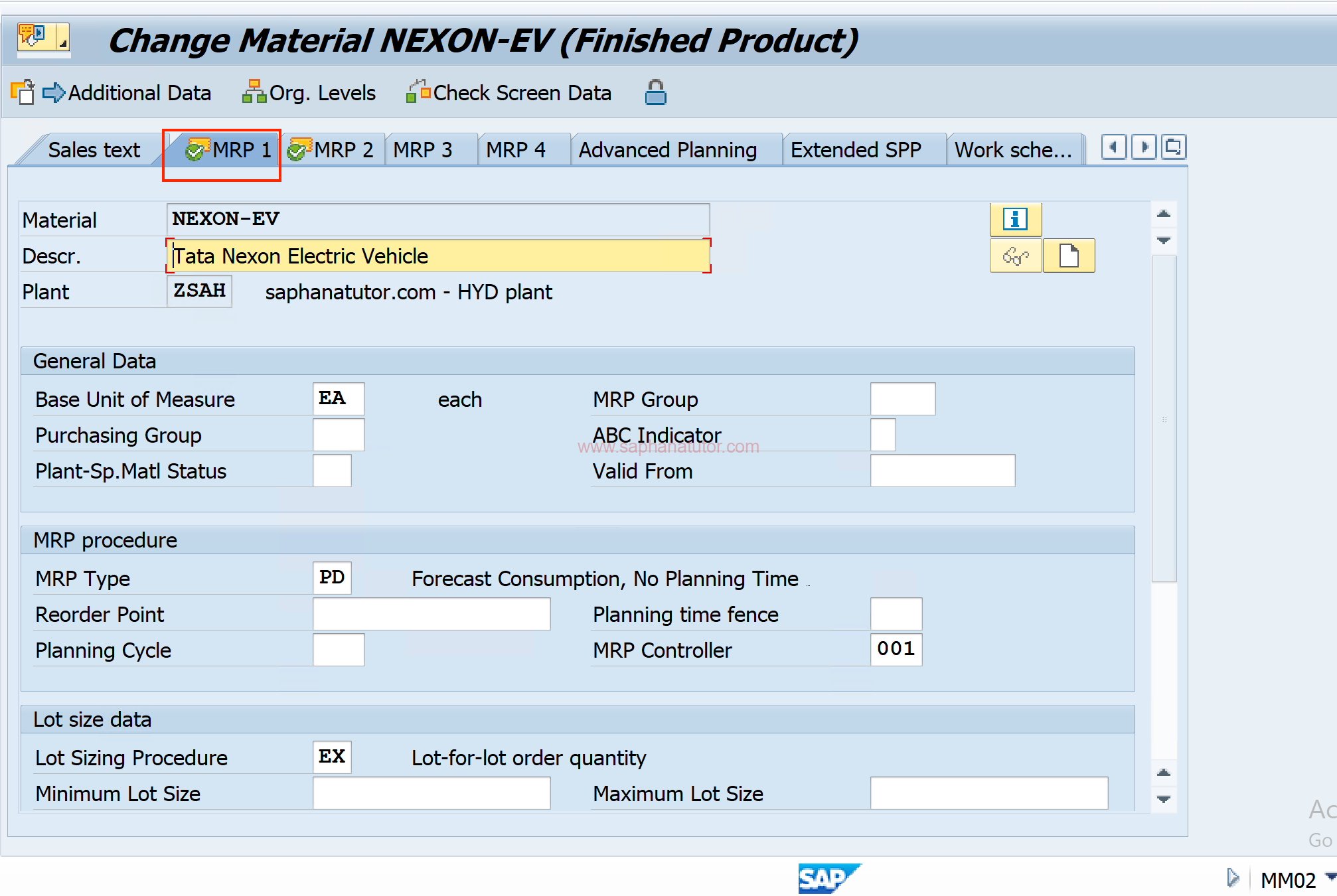
MRP 2 View
- Schedule Margin Key: This is identical to the MRP controller setting.
- Procurement Type: This field determines if the material is produced in-house, obtained from external sources, or a combination of both.
- In-House Production Time: This refers to the duration required to manufacture the goods.
- Planned Delivery Time: This is the estimated time it takes for goods to be delivered from the vendor’s location to the manufacturing plant.
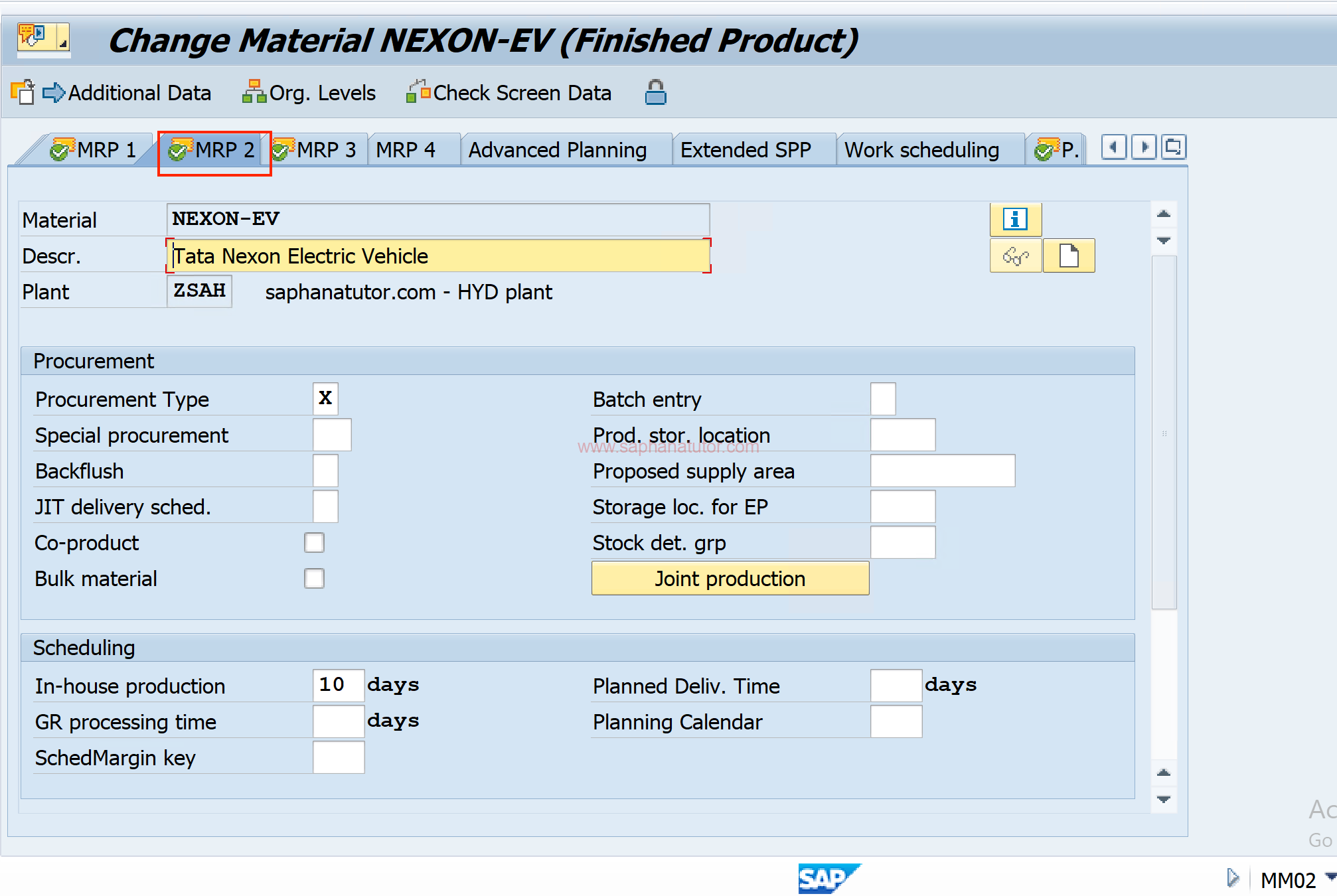
General Plan Data storage 1 View
Storage Conditions is one of the parameter that affects storage location determination in delivery documents. This view pertains to information related to the material’s storage and production. It includes:
- Plant: Identifies the location where the material is stored or produced.
- Storage Location: Specifies the specific storage area within the plant.
- Storage Conditions: Describes the environmental conditions required for storing the material.
- Availability Check: Defines the rules for checking material availability.
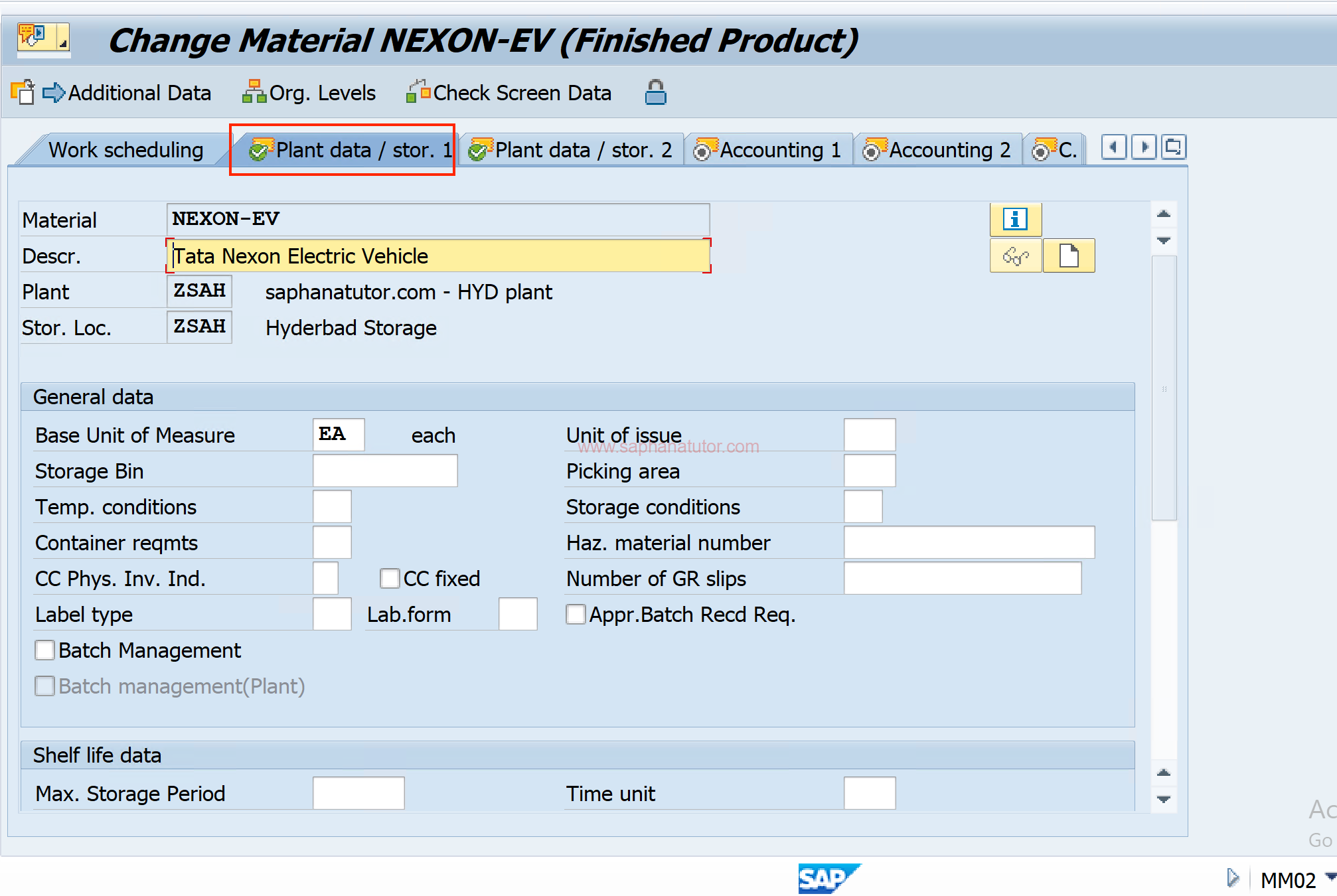
Sales: Plant View (Sales Organization Data 2)
This view provides additional sales-related data at the plant level, including:
- Sales Unit: Specifies a different unit of measure for sales at the plant level.
- Delivery Plant: Indicates the plant from which the material is delivered.
- Shipping Conditions: Describes specific conditions for shipping the material.
Plant Data / Storage View (Plant Data 2 / Storage Location Data 2)
This view further refines plant and storage-related information:
- Handling Unit Management: Specifies whether handling unit management is active for the material.
- Loading Group: Assigns a loading group for materials in transportation planning.
 Accounting View (Accounting 1)
Accounting View (Accounting 1)
Accounting-related data is stored in this view, covering aspects like:
- Valuation Class: Determines how the material is valued for accounting purposes. This categorizes products to help in accounting, differentiating between finished products and trading goods.
- Valuation class for finished product is 7920.
- Valuation class for Trading Good is 3100.
Cost of Goods Sold (COGS) Account Debit
to
Inventory Account Credit
- Price Control: Specifies the valuation method (standard price, moving average price). Determines whether the product cost is fixed (‘S’ for standard) or variable (‘V’ for moving). This choice affects how costs are recorded and managed
- Price Unit: Defines the unit in which the material’s price is calculated.
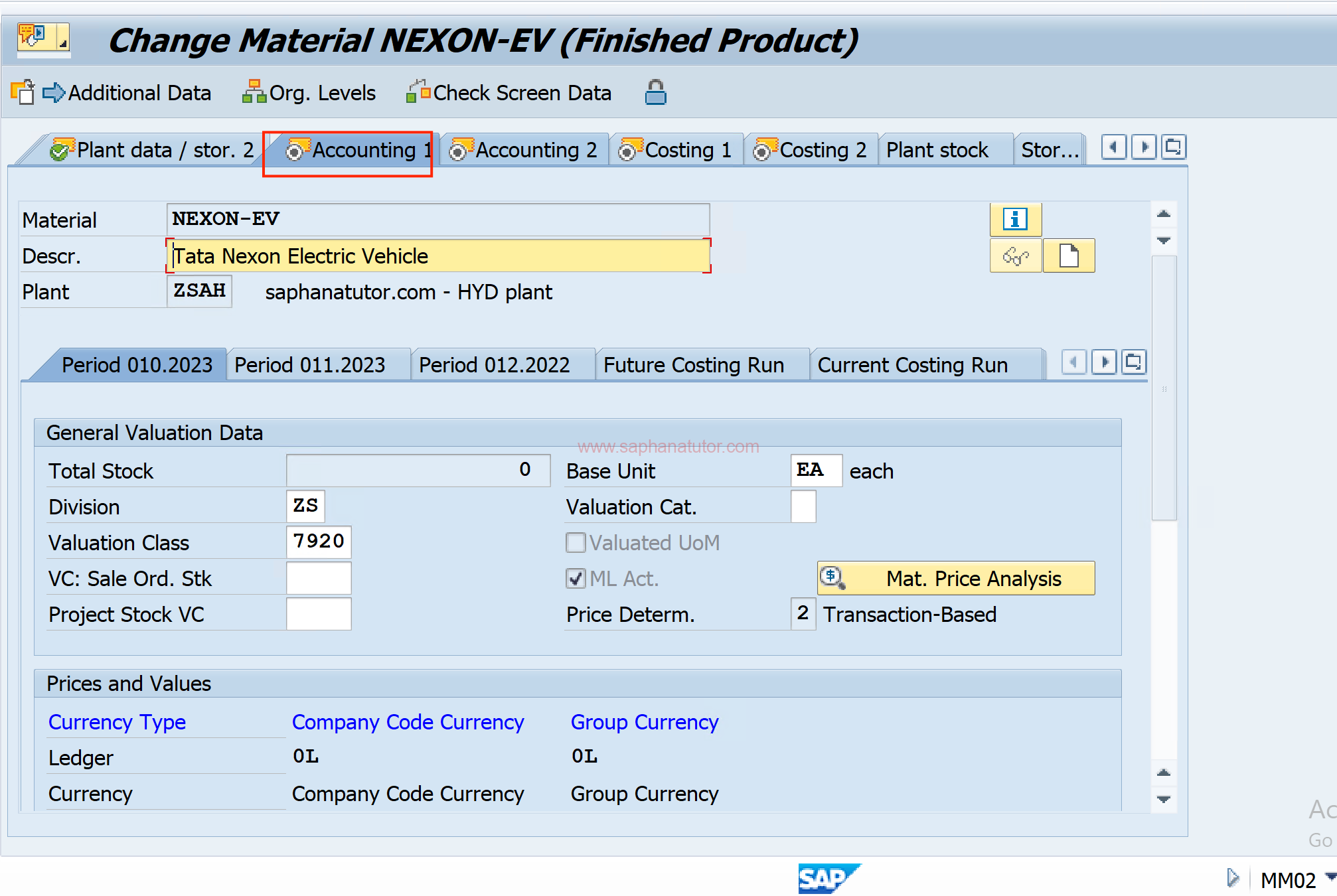
Tax Data View (Accounting 2)
This view includes tax-related information, such as tax codes and tax classification.
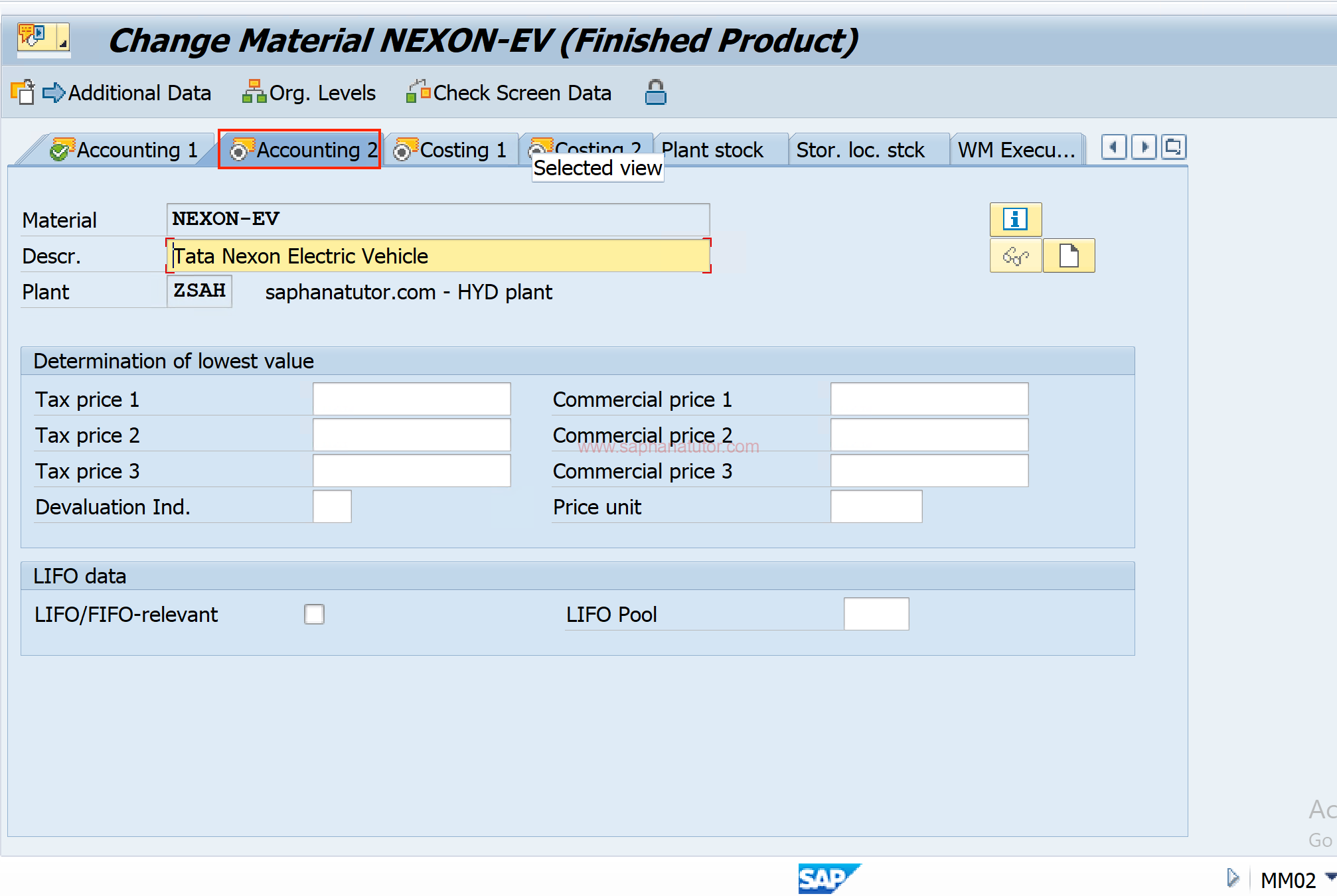
Important tips in Material Master in SAP
- To extend the material views, use the transaction code MM50.
- To view table data, use transaction code SE16N.
- To access the technical information of a table, use transaction code SE11.
- To check the list of all materials, use transaction code MM60.
- To change the cost in Material Master, use transaction code MR21.
- To determine the storage location, use transaction code OVL3.
- To determine the shipping point, use transaction code OVL2.
- To run MRP (Material Requirement Planning), use either transaction code MD01 or MD04.
- If you are unable to view all the views, go to transaction code OMS2 and select the relevant views.
